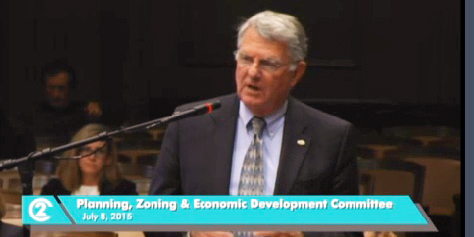
Park Board Commissioner Dave Mecklenburg encouraged the council committee to approve the originally proposed set of standards.
For several years, the city and parks department have been working with neighborhoods, citizens and developers to create a set a development standards for boulevards and parkways to apply to new developments in the Northland as well as redevelopment within the urban core.
Now, with a new city council set to take office, the current council is under self-imposed pressure to approve the standards before leaving office. The Board of Parks and Recreation Commissioners passed the proposed standards last month and this week, the city Plan Commission unanimously approved them.
But as they reached the Planning and Zoning Committee yesterday, developers offered a substitute that they said would ensure development would not come to a stop and others said would gut the original proposal.
Councilman Ed Ford says he still hopes to get the matter to the current city council for a vote on July 22.
What’s at stake is huge, according to those testifying on both sides of the issue.
“The park and boulevard system was substantially complete by 1912. It is still functional and beautiful and still provides a framework for high quality development,” Jim Rice told the council.
The city’s parks and boulevard system helped to create healthy urban neighborhoods, connect the city and distinguish Kansas City as uniquely beautiful, those testifying said. George Kessler and other architects of the system put into place standards that have served the city well. But over the years, some of those standards have been allowed to slip, with gas stations and drive through businesses popping up along urban core boulevards.
“Now in its second hundred years, we need to set new standards that are just as tough,” Rice said.
And, with the Northland poised for major growth in the Twin Creeks area, which some speculate could complete with Johnson County and attract 60,000 to 70,000 new residents over the next 30 years, some now think the original standards that applied to boulevard and parkway design in George Kessler’s day should be applied to the entire city.
“Driving down a boulevard in the Northland should be no different than driving down a boulevard in any other part of the city,” Rianna Deselich told the committee. She is a member of the Neighborhood Advisory Council and one of the people who has worked on developing standards for two years.
The proposal they have drafted would add restrictions and standards for land use adjacent to and within 150 feet of parks, boulevards and parkways.
But developers counter the standards could kill development, especially in the Northland.
“We want parkways to be more than a road system. We want them to be a development tool,” Hunt Midwest CEO and President Ora Reynolds said. She warned the standards could lead to a set of beautiful roads with no businesses on them.
“There are no restrictions in surrounding communities that are competing with Kansas City” for residential and commercial development, Doug Patterson of the Homebuilders Association, told the committee.
While both sides agree that a substantial amount of consensus has been reached in the lengthy discussions, several major points of difference remain:
- Street facing development: The original proposal calls for residential structures to face a boulevard. The city staff, in its report, points out that strong Kansas City neighborhoods such as those along Brookside Boulevard, Rockhill Road and Harrison Boulevard and Parkway, all face the boulevard. The developer group prefers lots to back up to a parkway, arguing that lots fronting onto parkways are not desirable due to traffic and high rates of speed and that home buyers avoid them.
- Orientation to the street and parking in front of buildings: The original proposal calls for an entrance on the front or side of a commercial building and no parking between the front of the building and the boulevard or parkway. The developer group wants that prohibition taken out of the ordinance.
- Prohibition of gas stations adjacent to or within 150 feet of a park, boulevard or parkway. The original proposal would prohibit gas stations or fuel sales; the developers proposal would allow them as a special use.
- Requirement for 60 percent transparency for commercial buildings. This means that 60 percent of the ground floor of a building along a boulevard or parkway must be a glass window or door. The developers object to this percentage.
- Drive-through windows must be on the side or rear of the building, according to the original proposal.The developer group is fighting for drive-throughs to be allowed on the front of parkway buildings.
Following the testimony, committee members said they would still like to make a decision before leaving office. They agreed to table a vote until July 22.
Chairman Ford asked City Planning Director Jeff Williams and other staff to work with the developers to try to work out a middle ground between the two proposals over the next two weeks.
But he says on behalf of himself, his fellow council members who have heard hours of testimony, and the public that has participated, the issue needs to be resolved.
“I think we owe everyone in this room a vote,” he said.



Trackbacks